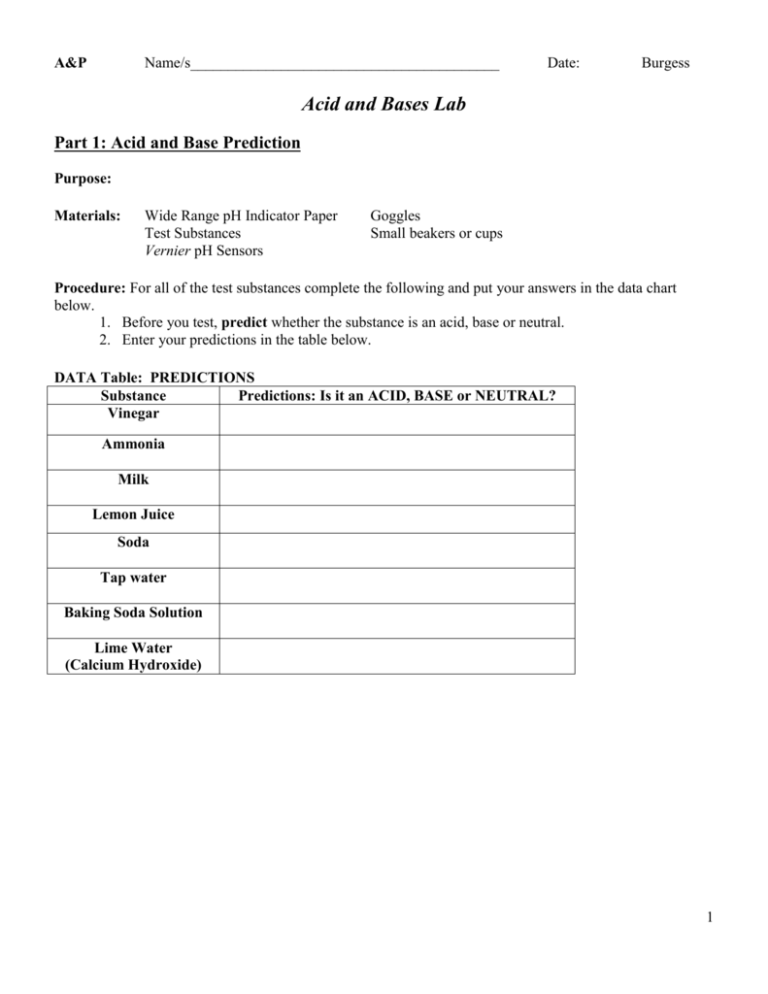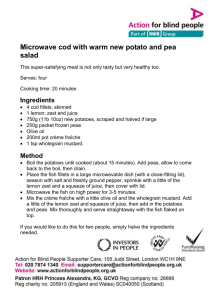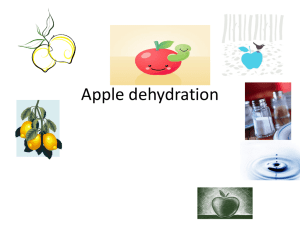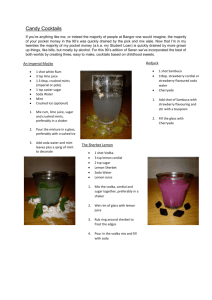ACIDS AND BASES LAB
advertisement

A&P Name/s_________________________________________ Date: Burgess Acid and Bases Lab Part 1: Acid and Base Prediction Purpose: Materials: Wide Range pH Indicator Paper Test Substances Vernier pH Sensors Goggles Small beakers or cups Procedure: For all of the test substances complete the following and put your answers in the data chart below. 1. Before you test, predict whether the substance is an acid, base or neutral. 2. Enter your predictions in the table below. DATA Table: PREDICTIONS Substance Predictions: Is it an ACID, BASE or NEUTRAL? Vinegar Ammonia Milk Lemon Juice Soda Tap water Baking Soda Solution Lime Water (Calcium Hydroxide) 1 Part 2: Acid and Base Determination Purpose: Materials: Wide Range pH Indicator Paper Test Substances Vernier pH Sensors Goggles Small beakers or cups transfer pipets (1 full pipet = approx. 5 mL) NOTE: Keep all beakers of solutions to use for next experiment using the Vernier pH meter. Procedure: For all of the test substances complete the following and put your answers in the data chart below. 1. Write a purpose above for this part of the lab. 2. Put on your goggles! 3. Place a small amount (~ ¼ oz) of the solution in the beaker/cup. Label the beaker 4. Carefully dip a strip of pH indicator paper into the substance and record the color results and compare to color chart on the container. 5. Record the pH value and determine whether it is an acid, base or neutral. Enter this data in the table. DATA TABLE: pH Paper Test Substance PAPER COLOR pH Value Acid, Base or Neutral Vinegar Ammonia Milk Lemon Juice Soda Tap water Baking Soda Lime WaterCalcium Hydroxide 2 Use the beakers of solutions from the previous experiment. Procedure: Materials: 1. 2. 3. 4. 5. 6. 7. 8. 9. Goggles Test Substances (from previous experiment) Vernier pH Sensors and display Write a purpose above for this part of the lab. Put on your goggles! Use the beakers of solutions from the previous experiment. Turn on the Vernier monitor and be sure the pH sensor is connected. Carefully remove the pH sensor from the calibration fluid. Rinse the tip of the sensor with tap water. Blot dry with paper towel. Carefully dip the pH sensor into the substance and allow to remain in solution for 10 sec. Record the pH value displayed on the Vernier monitor and determine whether it is an acid, base or neutral. Enter this data in the table. Rinse the pH sensor between each different substance that is tested. After all substances are tested, rinse pH sensor with tap water, blot dry and place in calibration fluid. Place in beaker to stand upright. DATA CHART: Vernir pH Sensor Determination Substance pH Value Vinegar Acid, Base or Neutral Ammonia Milk Lemon Juice Soda Tap water Baking Soda Lime Water (Calcium Hydroxide) ANALYSIS: Write the name of each substance at the point along the scale that corresponds with its pH. You may need to write sideways to fit this on to the scale below. 0__________________________________7___________________________________14 3 Conclusion Questions 1. Which solutions are the strongest acids? 2. Which solutions are the strongest bases? 3. Which solutions were neutral? 4. Compare your results with your predictions. Which ones were incorrect? 5. The pH of hair and skin is 4.5 - 5.5. Which Solutions would be harmful to your hair and skin? Why? 7. Predict what would happen to the pH of vinegar if ammonia were added to it. 4 Part 3: Buffers: Where to turn for Heartburn? Purpose: Hypothesis: Materials Three samples of Antacids: 1- Milk of Magnesia or PeptoBismal 2- AlakaSeltzer or Brioschi 3- Tums or Rolaids pH Sensors 15 ml Beakers Graduated Cylinders stirring rod Lemon Juice Solution Pipets Procedure: Write a purpose and hypothesis above for this part of the lab. Part 1: Milk of Magnesia 1. Get a 50-100 ml beaker and pour in 2 ml of Milk of Magnesia (5 mL is contents of approx. 1 transfer pipet) 2. Take the initial pH of the antacid with pH paper. Record in chart below 3. Get a 50-100 ml beaker and pour 1 ml of lemon juice into 6 ml of water 4. Take the pH of lemon juice solution with Vernier pH Sensor and record in chart next to 0 ml. 5. Add 1.0 ml of the antacid solution into the lemon juice using a graduated pipette. Stir and record the pH using the Vernier pH Sensor in the data chart. 6. Keep adding 1.0 ml of the antacid solution until the solution reaches pH 7. Part 2: Alka-Seltzer 1. Pour 5 ml of water into a 15 ml beaker. 2. Add 2 alka- seltzer tablets, allow to dissolve. 3. Take the initial pH using pH paper. Record pH in the chart below 4. Get another 100 ml beaker and Pour 10 ml of lemon juice into 60 ml of water 5. Take the pH of lemon juice solution with Vernier pH Sensor and record in chart next to 0 ml. 6. Add 1.0 ml of the antacid solution into the lemon juice using the transfer pipette. Stir with stirring rod and record the pH using the Pasco senor in the data chart. 7. Keep adding 1.0 ml of the antacid solution until the solution reaches pH 7. Part 3: Extra Strength Rolaids 1. Take 1 Rolaids tablets and carefully grind them up using the mortar and pestle. Scrape the powdered antacid into a small beaker and add 3 ml of water. 2. STIR WELL until almost all dissolved. 3. Record the pH with pH paper in the chart below. 4. Get another 150 ml beaker and Pour 10 ml of lemon juice into 60 ml of water 5. Take the pH of lemon juice solution with Vernier pH Sensor and record in chart next to 0 ml. 6. Add 1.0 ml of the antacid solution into the lemon juice. Stir and record the pH using the Pasco senor in the data chart. 7. Keep adding 1.0 ml of the antacid solution until the solution reaches pH 7. 5 Data Table: Buffering acidity with antacids Milk of Magnesia or Pepto-Bismol pH: Alka-Seltzer pH : Rolaids or TUMS pH: Antacid Solution 0 ml 1 ml 2 ml Antacid Lemon Juice Solution pH: 0 ml 1 ml 2 ml Antacid Lemon Juice Solution pH: 0 ml 1 ml 2 ml Lemon Juice pH: Analysis: Using Excel, make a plotted line graph showing the data you collected. The x-axis of should be amount and type of solution added. The y-axis should show the pH. Title your graph “The Ability of an Antacid to Buffer an Acid” Conclusion Questions: 1. Which of the three antacids you tested was more effective at neutralizing acid? Explain how your results support or refute this conclusion. 2. Acids add H+ to a solution. Antacids contain bases and/or buffers. How do antacids neutralize acid? 3. Your stomach produces hydrochloric acid with a pH 2. What is the function of this acid in your stomach? 4. What causes “heartburn”? (Hint: Your heart is NOT burning) 6







